Located on both banks of the Vistula River in central Poland, Warsaw serves as the nation’s political, economic, and cultural hub, as well as its largest city. Covering an area of about 517 square kilometers, Warsaw has an estimated population of 1.79 million. It is also known for having one of the highest per capita green space ratios in the world.
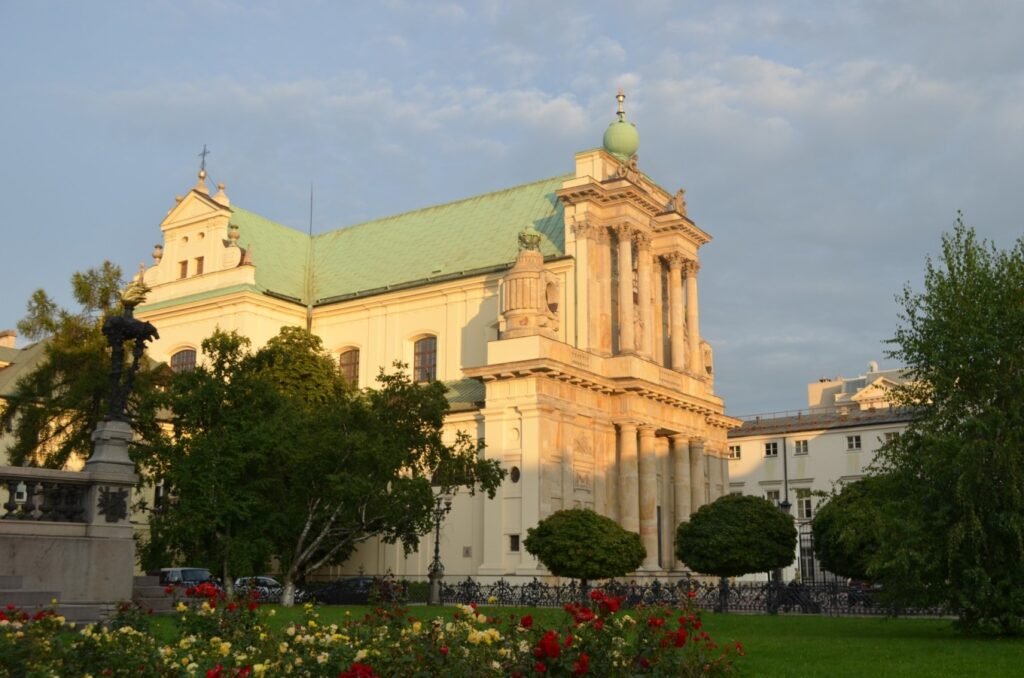
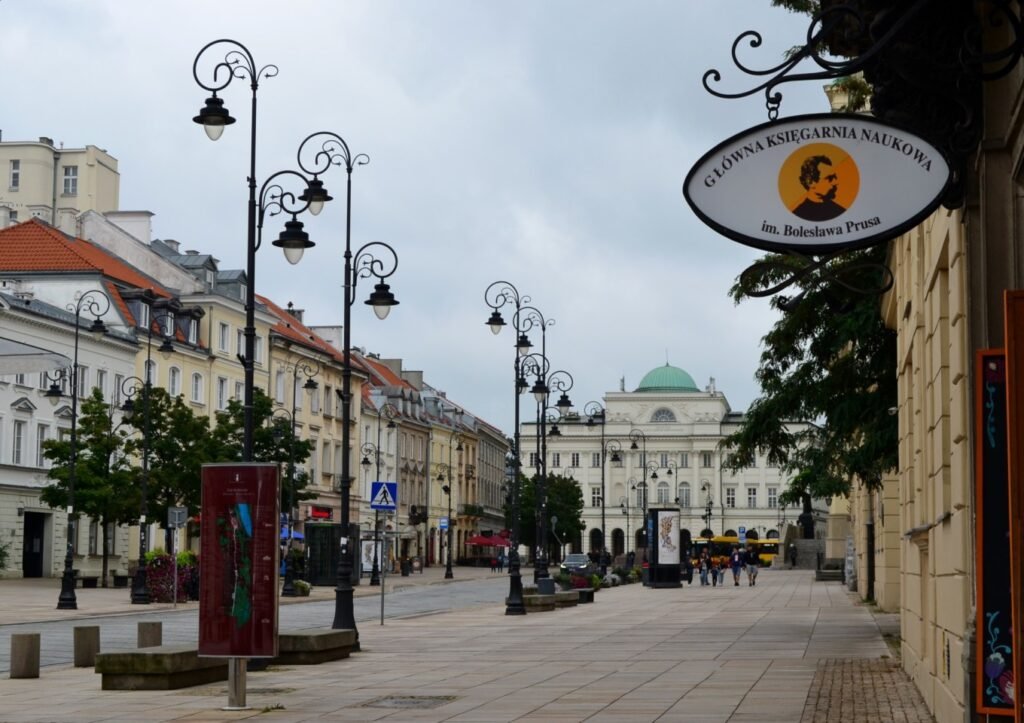
In Polish, Warsaw is written as Warszawa, meaning “belonging to Warsz,” which is a shortened form of the male name Warcisław. However, folklore offers a more romantic interpretation. According to legend, the city’s name comes from a love story between Wars and Sawa, two lovers who defied a king’s opposition to their relationship and settled here to build their home.
One of the most famous symbols of Warsaw is the Mermaid Statue, located in the Old Town square. The story goes that long ago, a mischievous mermaid stirred up waves and chased fish away, angering fishermen. She was eventually captured by merchants, but the local fishermen, hearing her cries, freed her. Grateful for their kindness, the mermaid vowed to protect the city, taking up a sword and shield as her symbols.
Interestingly, a similar mermaid statue stands in Copenhagen, Denmark. A popular tale suggests that the Warsaw and Copenhagen mermaids were sisters, with one staying near the Baltic Sea while the other found a home in Copenhagen.
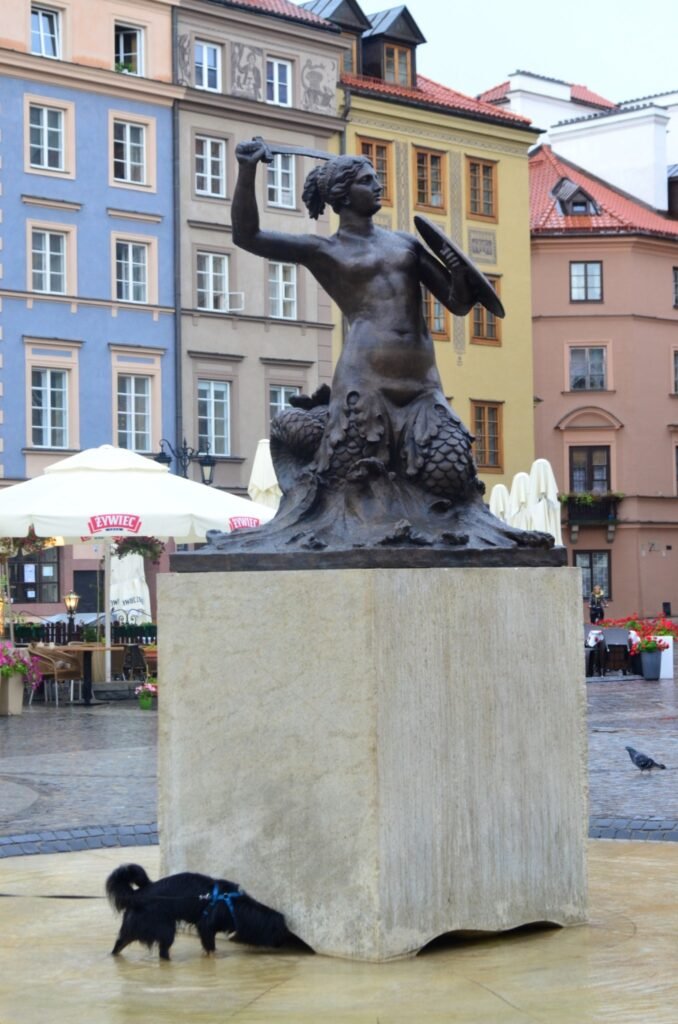
Warsaw, a city known for its rich historical and cultural significance, has a complex and turbulent past, making it one of the most captivating capitals in Europe. The city has been inhabited since the 10th century, with its foundation as a town dating back to the mid-13th century. In 1569, King Sigismund III Vasa of Poland transferred the capital from Kraków to Warsaw, establishing its political significance.
In 1795, Poland was partitioned by Russia, Prussia, and Austria, marking the beginning of 123 years during which Poland ceased to exist as an independent state. After World War I ended in 1918, Warsaw was reinstated as the capital of Poland. However, the city faced devastation once again during World War II when it was occupied by Nazi Germany, leaving much of the beautiful Old Town in ruins before it was liberated by Soviet forces.
The relocation of the Polish capital from Kraków to Warsaw was primarily influenced by Warsaw’s proximity to Lithuania. During the era of the Polish-Lithuanian Commonwealth, the shorter distance made Warsaw a more convenient location for holding federal elections and assemblies.
Today, Castle Square (Polish: Plac Zamkowy) serves as the gateway to the Old Town and is home to one of Warsaw’s most iconic landmarks—the Sigismund’s Column (Kolumna Zygmunta). Erected to honor King Sigismund III Vasa, the column is visible from afar and remains a beloved meeting point for locals.
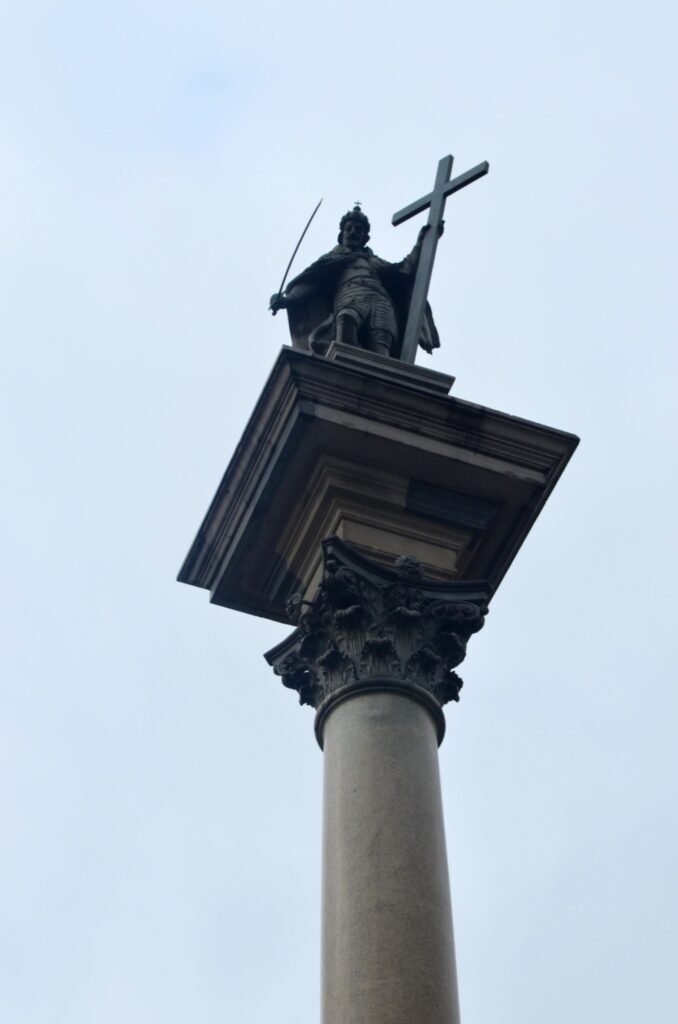
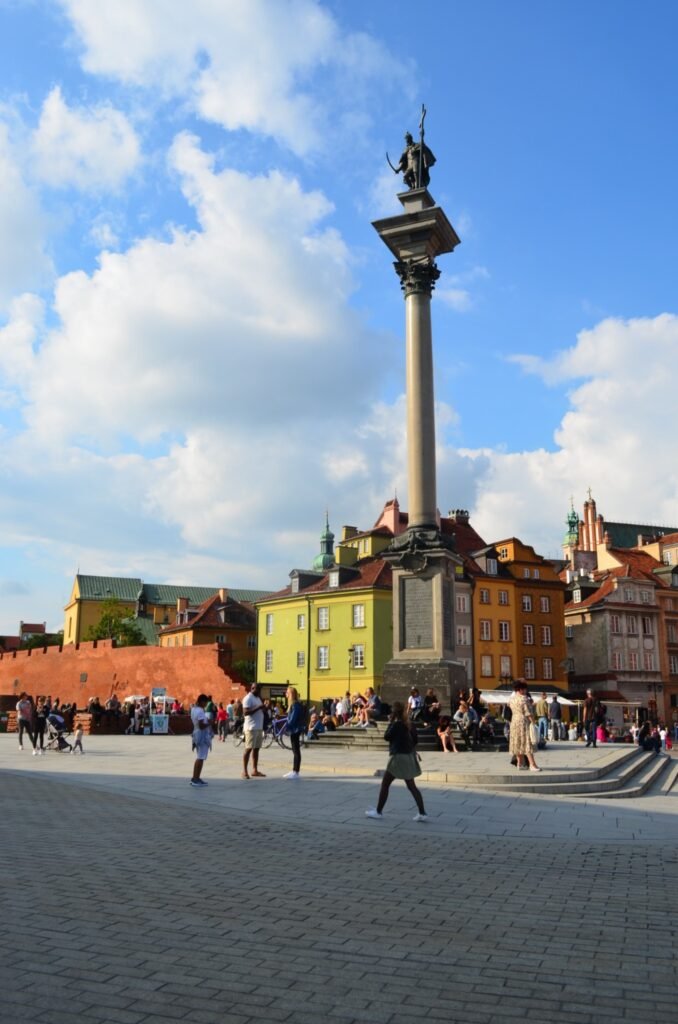
Sigismund’s Column, constructed between 1643 and 1644, was commissioned by King Władysław IV in honor of his father, Sigismund III Vasa. The column showcases elements of both Roman style and Renaissance influence. Remarkably, it holds the distinction of being the first non-religious monument in Poland, marking a significant cultural milestone in the nation’s history.
Over the centuries, the column has undergone several restorations due to damage from wars and natural wear. The original column, replaced during renovations, now rests near the entrance to the Royal Castle, not far from its original location.
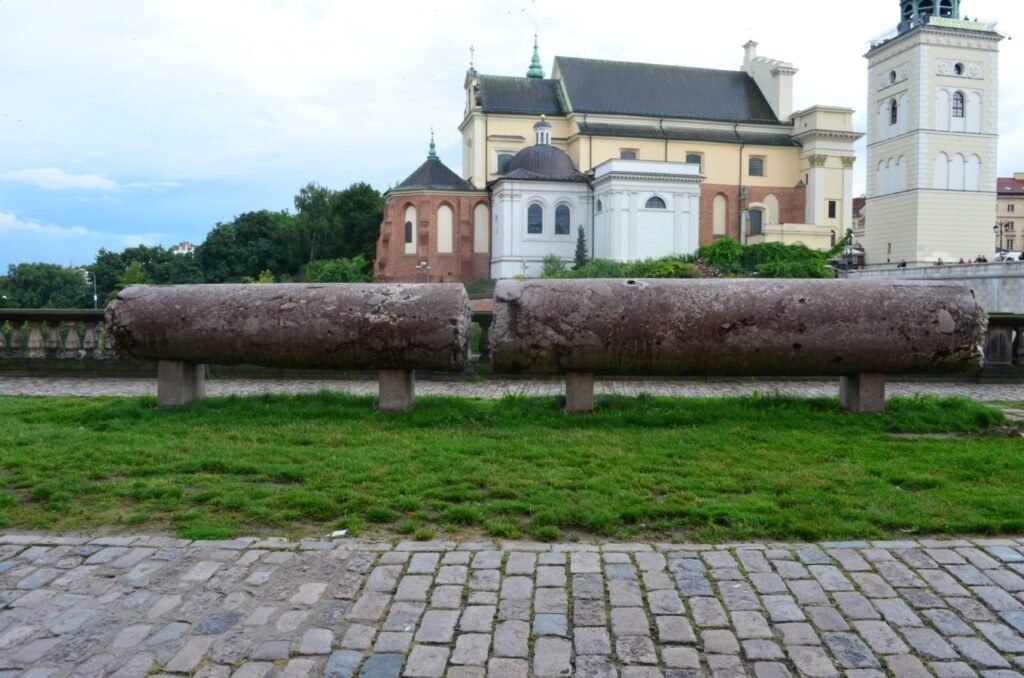
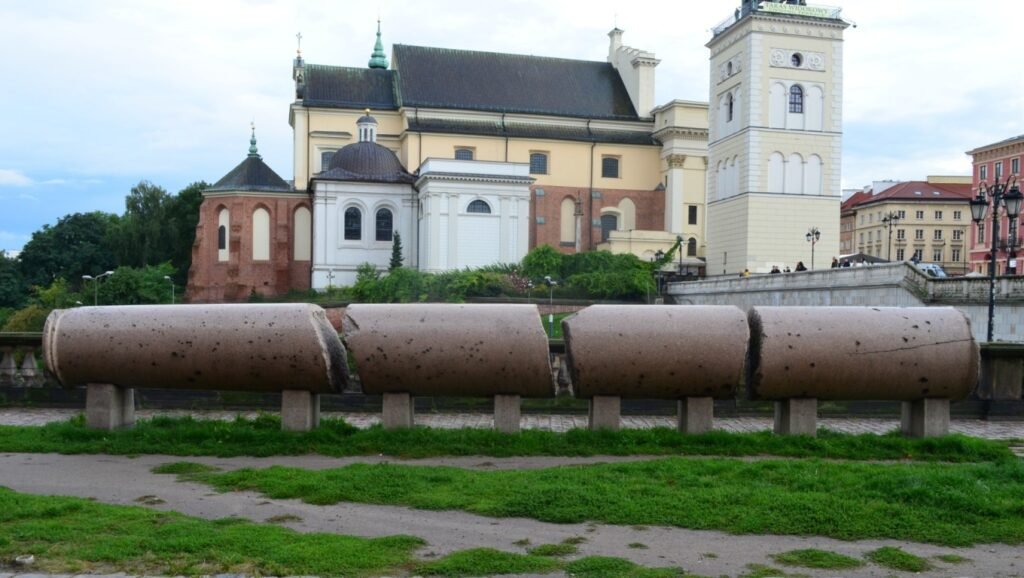
The Resilient Heart of Warsaw – The Old Town
The most captivating and legendary part of Warsaw is its Old Town. In 1944, after the Warsaw Uprising failed, Nazi forces bombed the area, leaving nearly 85% of the Old Town in ruins, flattened to the ground. Following the end of World War II, Poles faced immense challenges yet remained determined to restore the Old Town to its original state, forcing the Soviet government to yield to their resolve. When news of the reconstruction spread, hundreds of thousands of Poles from across the country gathered to contribute their efforts, with many even donating funds to rebuild structures that were denied Soviet financial support.
Guided by historical blueprints, surveys, and surviving images, and fueled by the unyielding efforts of the Polish people, the reconstruction of Warsaw’s Old Town was completed by the mid-1960s. This monumental achievement silenced the pessimistic voices in the West that had once declared, “Warsaw will never return, at least not within 100 years.”
The reconstruction efforts garnered widespread recognition, with most buildings faithfully reflecting their 14th- to 18th-century styles. Due to the exceptional care given to preserving historical elements and the Poles’ unwavering commitment to protecting their national heritage, UNESCO made an extraordinary decision in 1980 by listing the reconstructed Warsaw Old Town as a World Cultural Heritage site. This groundbreaking recognition reshaped the concept of “authenticity” in cultural heritage and sparked discussions within the field of preservation for decades to come.
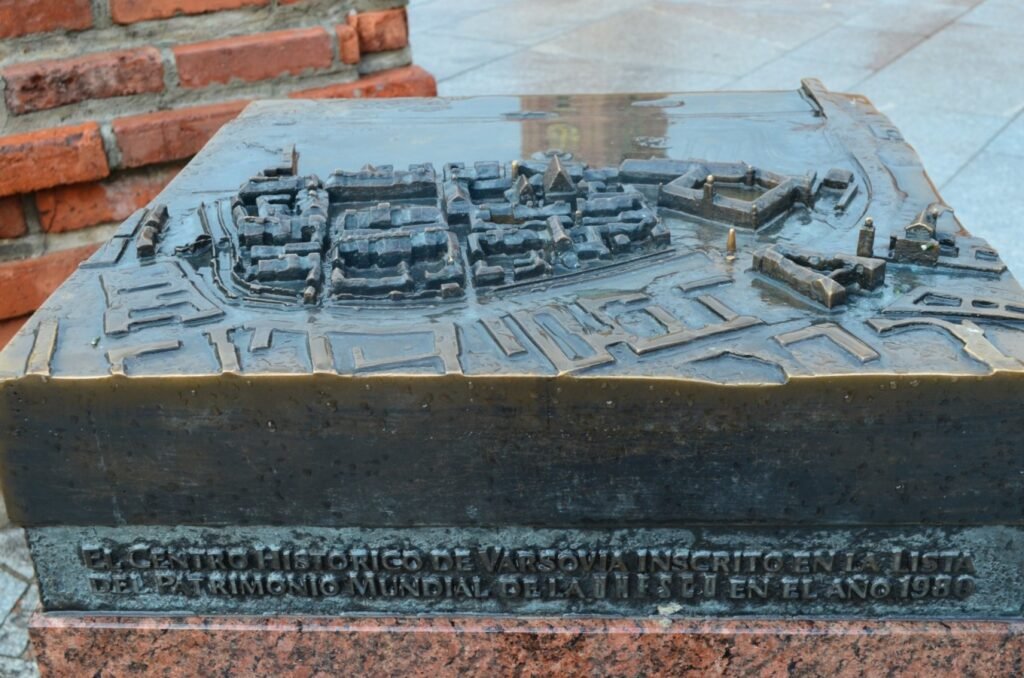
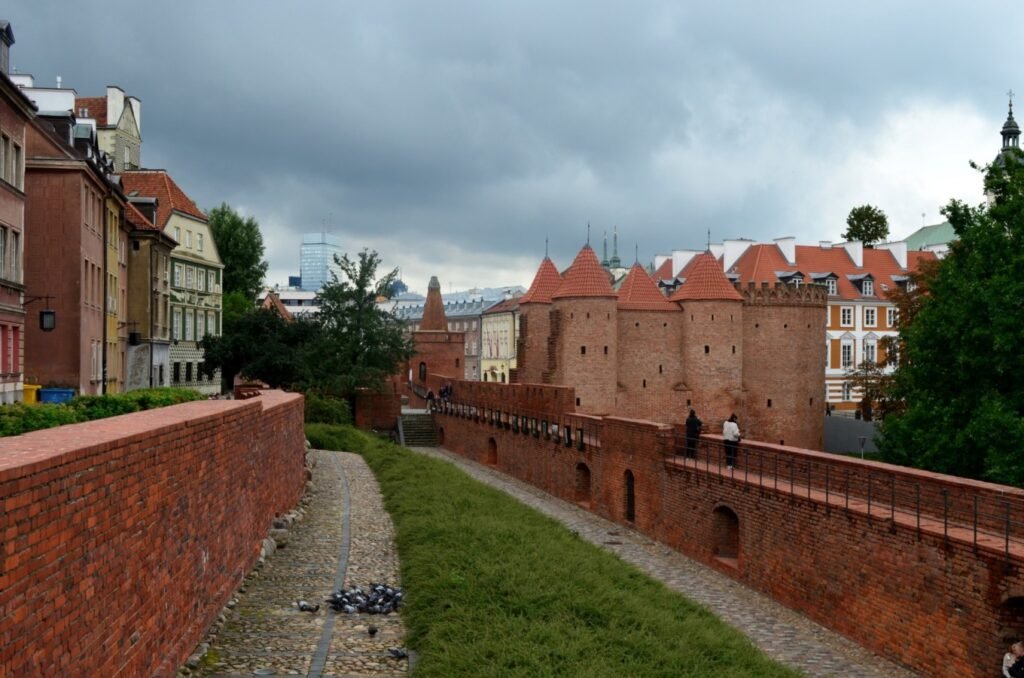
Today, Warsaw’s Old Town remains the most charming corner of the city. Lined with vibrant “ancient” buildings, these streets are home to both residences and a variety of restaurants and shops, filling every corner with the lively pulse of everyday life. On sunny weekends, the Old Town buzzes with activity, with crowds of people filling its streets. The Market Square becomes a hub of excitement, where tourists and locals mingle, taking photos, gathering with friends, raising glasses, chatting, and laughing. Adults enjoy leisurely meals and coffee at outdoor tables, while children run and play tirelessly through the streets. It’s a delightful scene of joy and togetherness, capturing the essence of a place where history meets the rhythm of modern life.
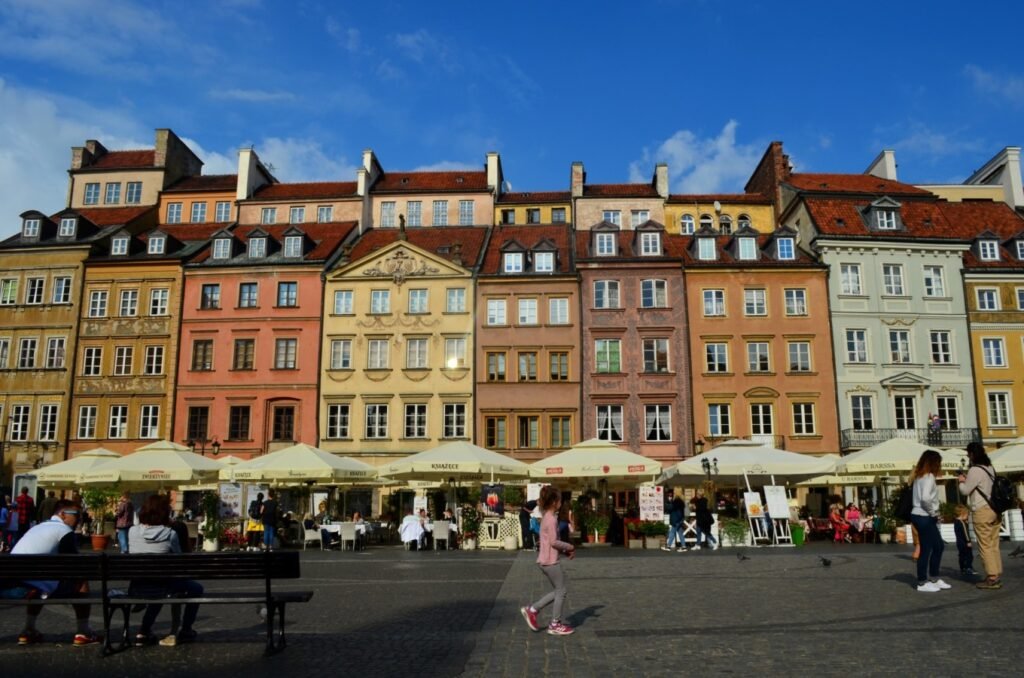
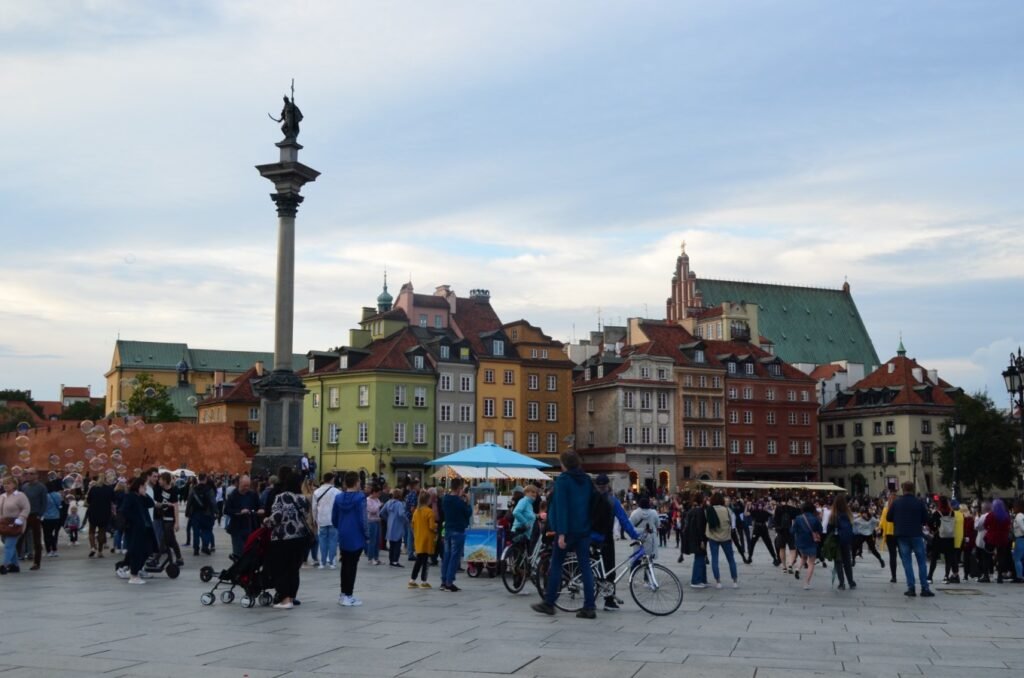
Architectural Highlights of Warsaw
Warsaw’s unique historical background has left the city with not only numerous stories but also distinctive architecture. One of the most frequented spots by visitors is the Presidential Palace, but it’s the neighboring buildings that often steal the show. Facing the Old Town, on both sides of the street, stand two elegant five-star hotels: Raffles Europejski Warsaw and the Bristol Hotel. Both are landmarks in the heart of Warsaw, known for their prime location and prestigious status.
These hotels are also referred to as the “father and son” masterpieces. To the left, the Europejski Hotel (Raffles Europejski) was designed by Enrico Marconi and opened in 1857 as one of Europe’s most luxurious and modern hotels of its time. It was later occupied by Nazi forces during World War II and suffered extensive damage in 1944. The building standing today is a carefully restored version of the original structure, preserving its grandeur while offering modern luxury.
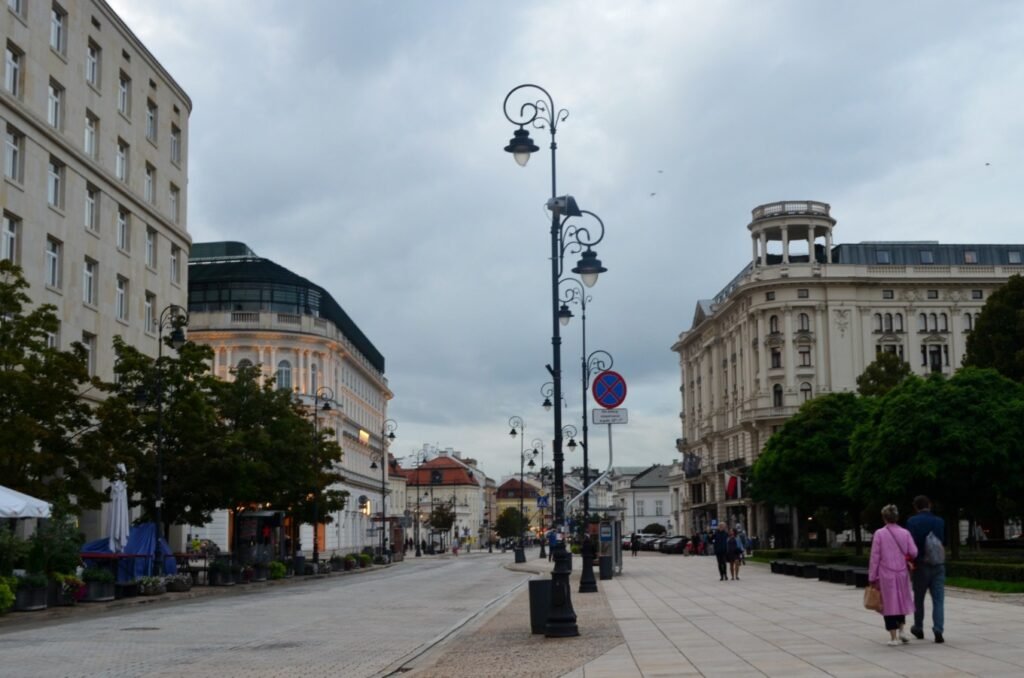
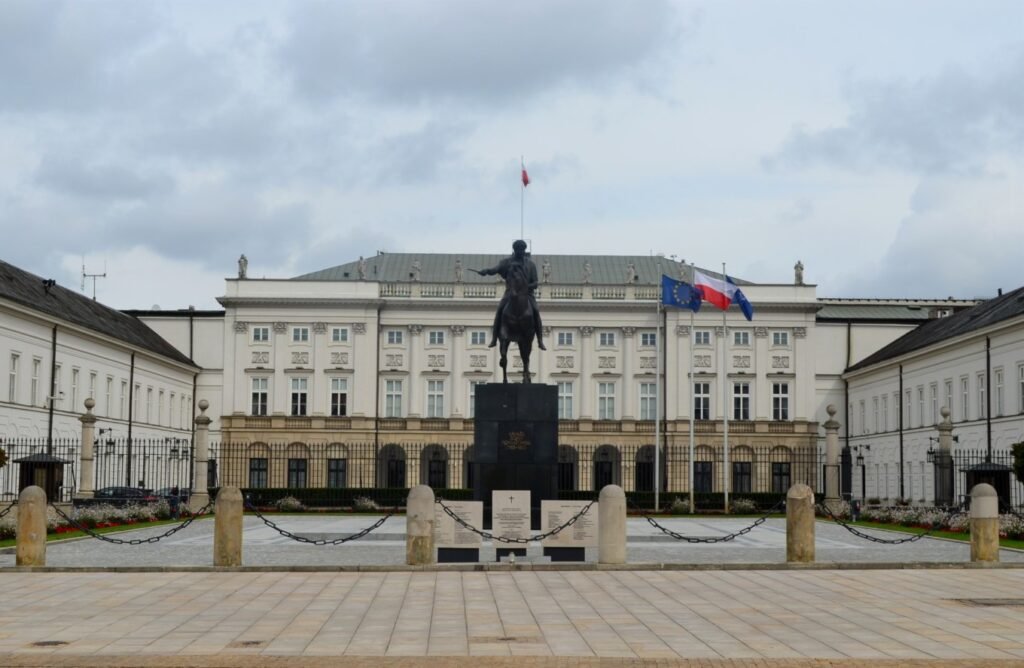
To the right stands the Bristol Hotel, designed by Władysław Marconi, Enrico Marconi’s son. Remarkably, this Neo-Renaissance building survived the war almost unscathed. Completed in 1901, it served as the administrative headquarters for the Nazi forces in Warsaw during World War II. After the war, it was nationalized and later transformed into the Warsaw University Library. In 1993, the building was restored to its former glory and reopened under its original name, the Bristol Hotel, continuing to shine as a symbol of elegance and resilience.
The two elegant and grand hotels, reflecting the luxury cars, fashionable ladies, and gentlemen passing by, shine as if they were always destined to host high society. Yet, they have quietly endured more than a century, witnessing the passing of their designers, surviving the brutalities of world wars, and observing the ebb and flow of societal changes. Now, they seamlessly and gracefully integrate into modern peaceful life—timeless without appearing weathered, luxurious without being gaudy, accessible yet exuding an air of distinction.
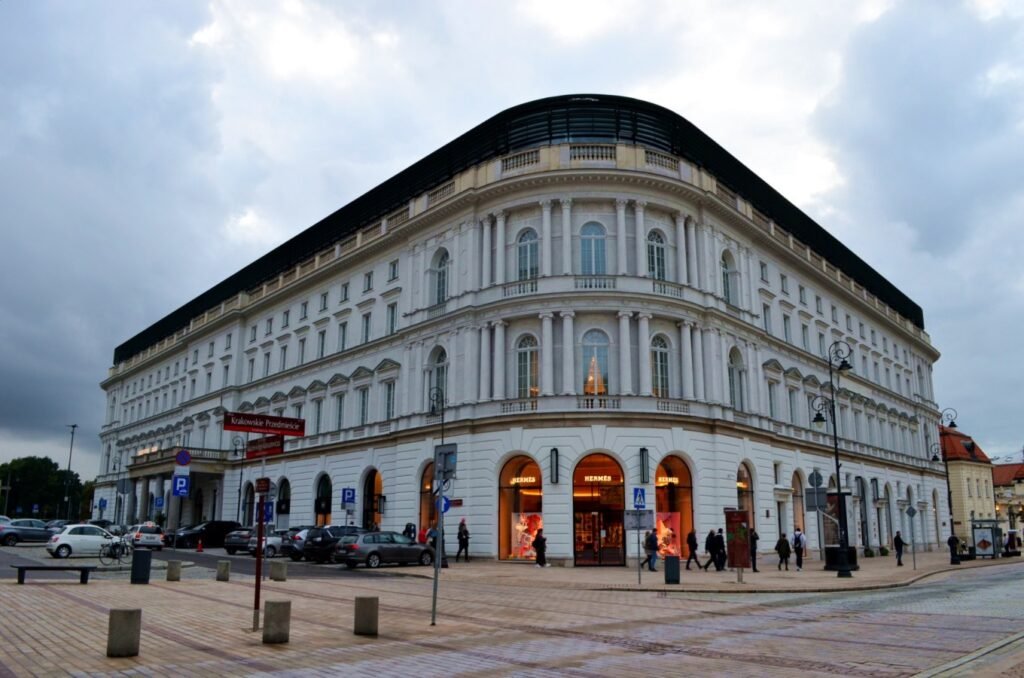
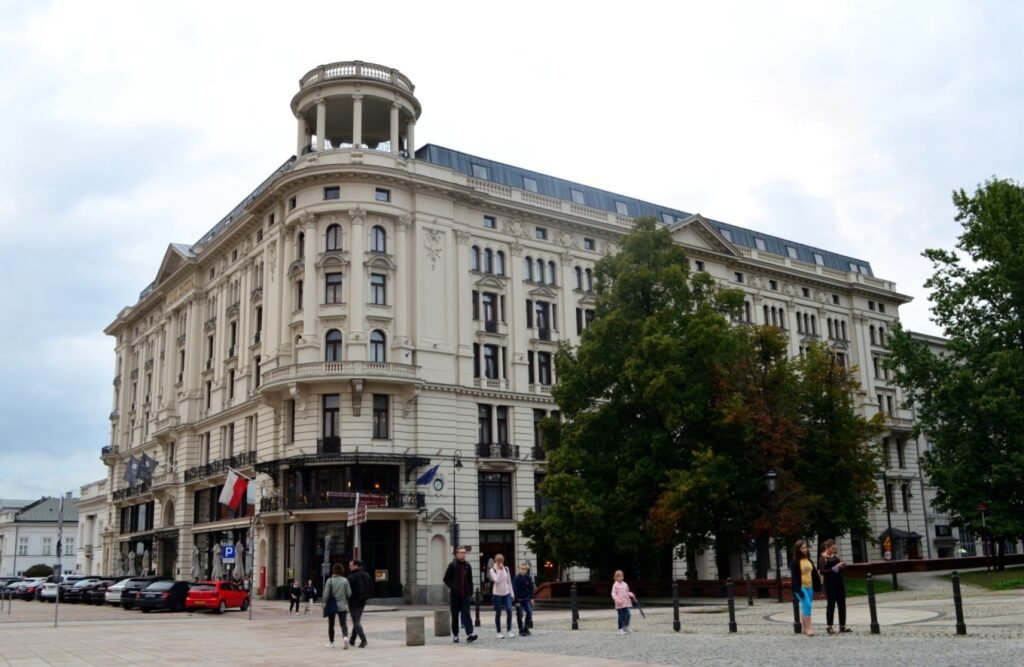
For many Poles, the period under Soviet control is much like the Palace of Culture and Science is to Warsaw—some may wish to erase it, many disdain it, but it remains an indelible part of history’s course, impossible to ignore.
The Palace of Culture and Science, built between 1952 and 1955, stands approximately 234 meters tall, making it the tallest building in Warsaw and one of its most iconic landmarks. Its distinctive “Stalinist architectural style” hints at the political and historical influences of its time. The palace was a gift from Joseph Stalin to the People’s Republic of Poland, designed by Soviet architect Lev Vladimirovich Rudnev and constructed within just three years by thousands of Soviet and local workers. Originally named the Stalin Palace of Science and Culture, the building has housed scientific and cultural institutions for decades, hosting numerous exhibitions and art performances. Visitors can also take the elevator to the observation deck on the 30th floor to enjoy a panoramic view of Warsaw.
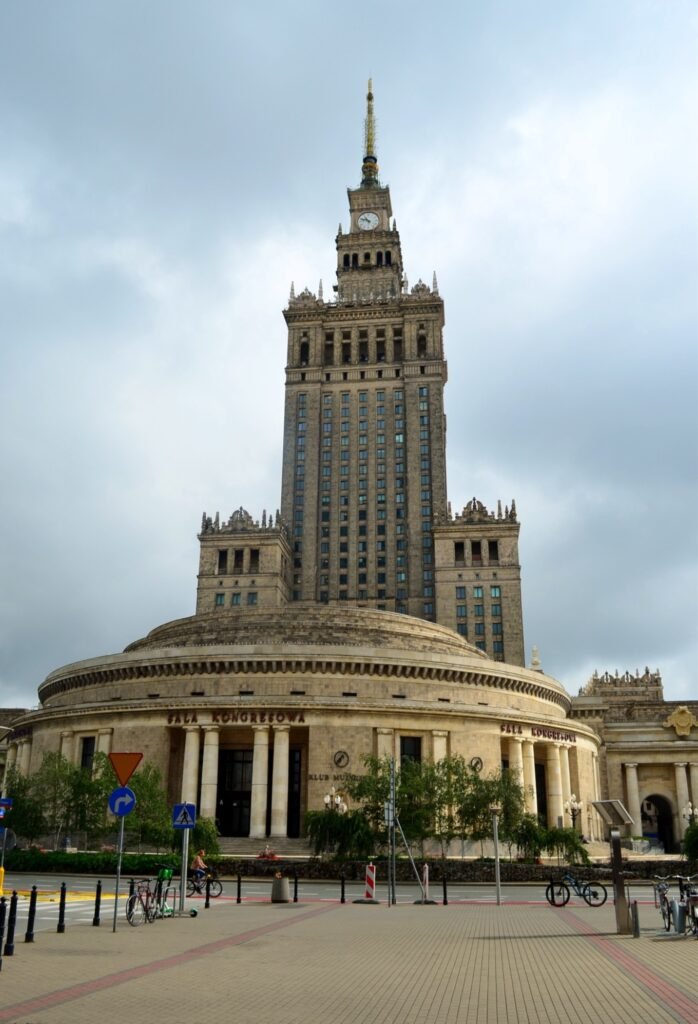
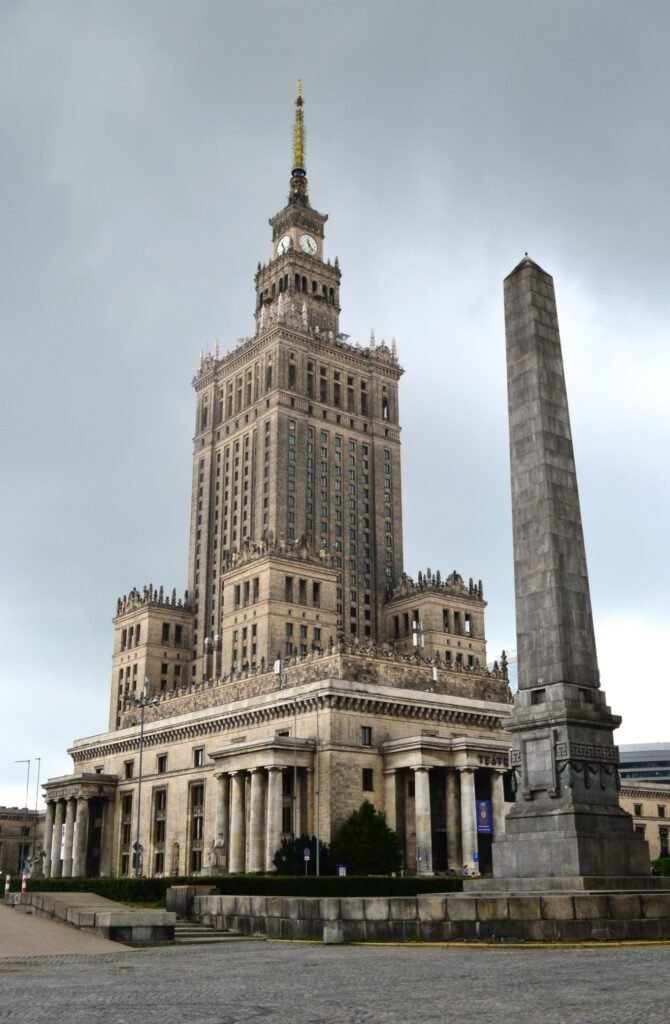
The University of Warsaw, founded in 1816, is the largest and one of the most prestigious universities in Poland.
Located in the city center, not far from the Old Town, the campus even includes several historic palaces. At the entrance, the university’s emblem is prominently displayed—a crowned Polish eagle, with five stars symbolizing the five original faculties: Theology, Law, Medicine, Philosophy, and the Humanities. To the left stands the goddess of Astronomy, and to the right, the goddess of Wisdom.
I entered the University of Warsaw’s campus one evening, greeted by a serene and peaceful atmosphere. A few people passed by, and a couple of students were practicing skateboarding. The campus buildings, elegant and dignified, took on a new warmth as night fell. Streetlights illuminated the white structures with a soft, orange glow, resembling the romantic flicker of candlelight, creating a scene that felt both cozy and enchanting.
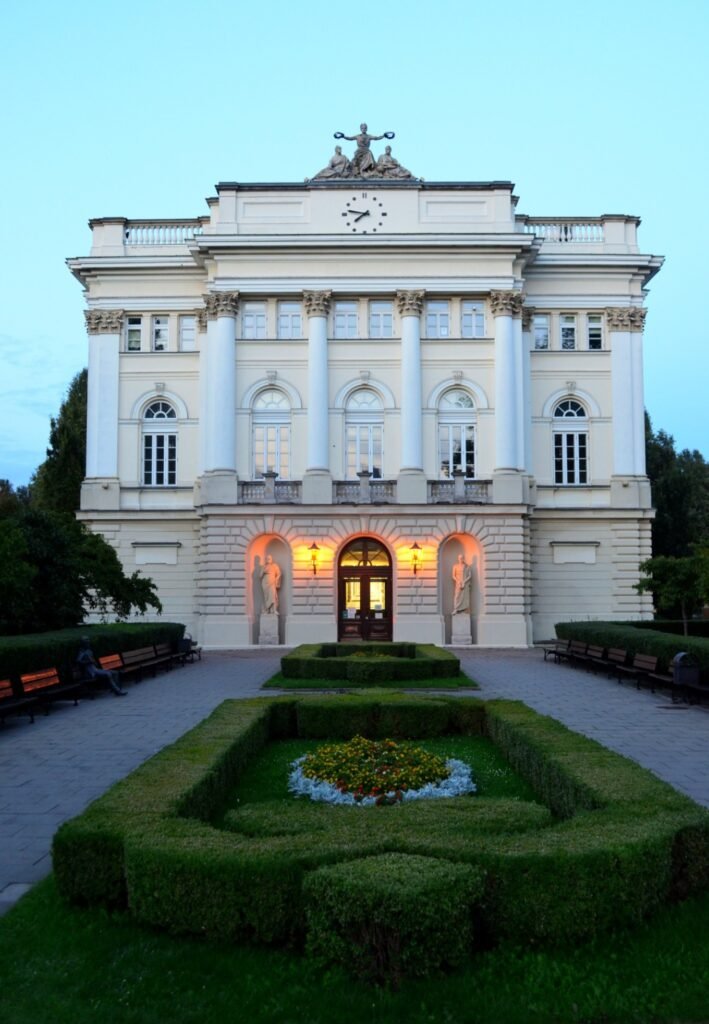
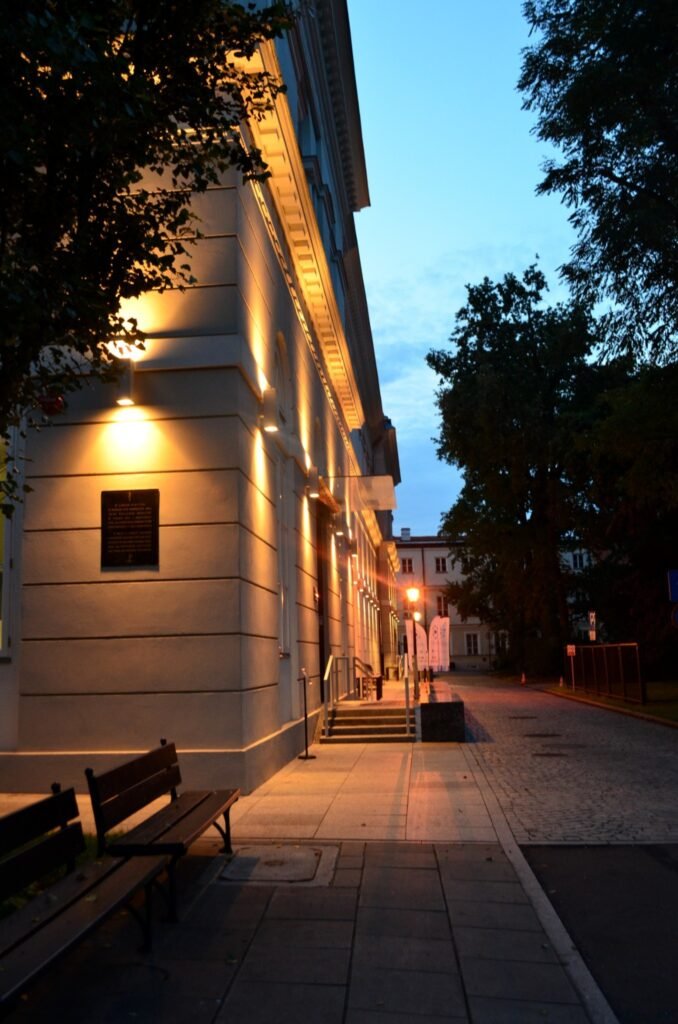
The Heart of Chopin
Warsaw Chopin International Airport—undoubtedly the most elegant and romantic airport name in my mind—reflects the deep and enduring connection between the famous Polish pianist and composer Frédéric Chopin and the city of Warsaw.
Chopin was born on March 1, 1810, in a suburb of Warsaw and later moved to the city with his family. He began composing at the age of seven and gave his first public performance at eight. By the time he was twelve, his teacher found it difficult to continue providing advanced instruction. From 1822 to 1829, Chopin studied composition and music theory at the Warsaw Conservatory. However, following the failure of the Polish uprising, he left for Paris in 1830, where he embarked on a celebrated career as a “poet of the piano.”
Drawing inspiration from Polish folk dances, Chopin’s works, mostly composed for piano, made him one of the foremost representatives of Romantic music in 19th-century Europe. Although he longed to return to Warsaw, he never did, passing away in 1849 in Paris. Honoring his final wish, Chopin’s sister transported his heart back to Warsaw, where it now rests embedded in a pillar inside the Holy Cross Church.
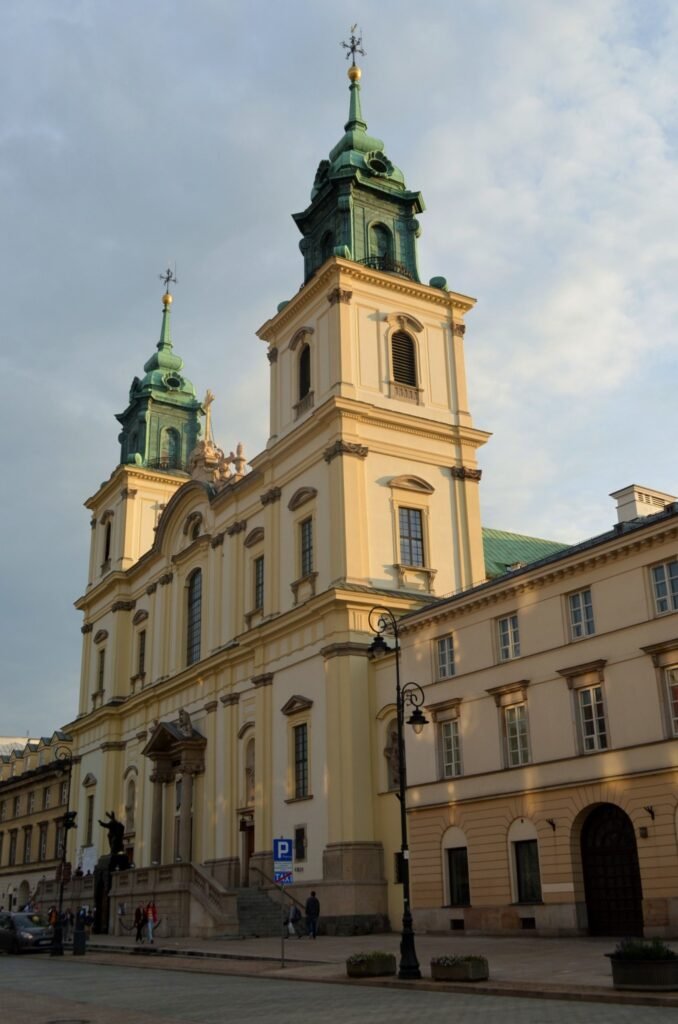
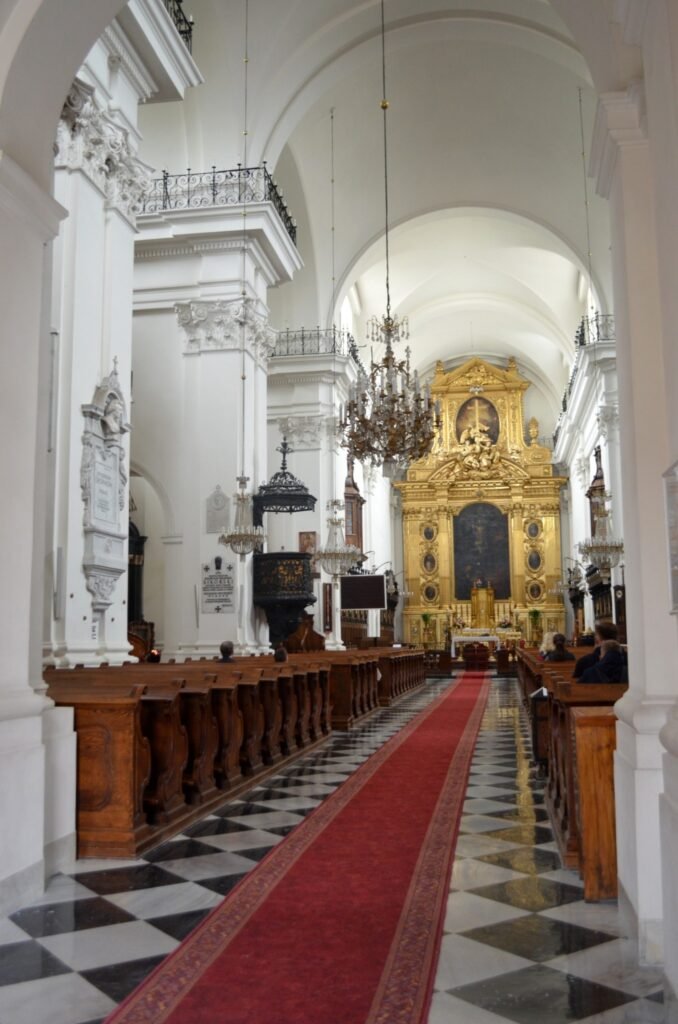
As one of the brightest figures in Warsaw and Poland’s history, Chopin’s legacy remains vividly alive in Warsaw nearly 200 years after his passing. His presence is felt throughout the city in many ways.
The Chopin Museum in Warsaw is one of the most essential places to visit, offering a comprehensive look at his short yet brilliant life. Visitors can enjoy an immersive experience with multimedia installations that allow them to listen to a range of Chopin’s works, including sonatas, waltzes, ballades, and nocturnes.
The museum also houses an art exhibit featuring paintings inspired by Chopin and his music. Upon entering, I was immediately drawn to one particular painting, but unfortunately, it was not available as a souvenir. I even took the opportunity to suggest to the staff that it be made into one.
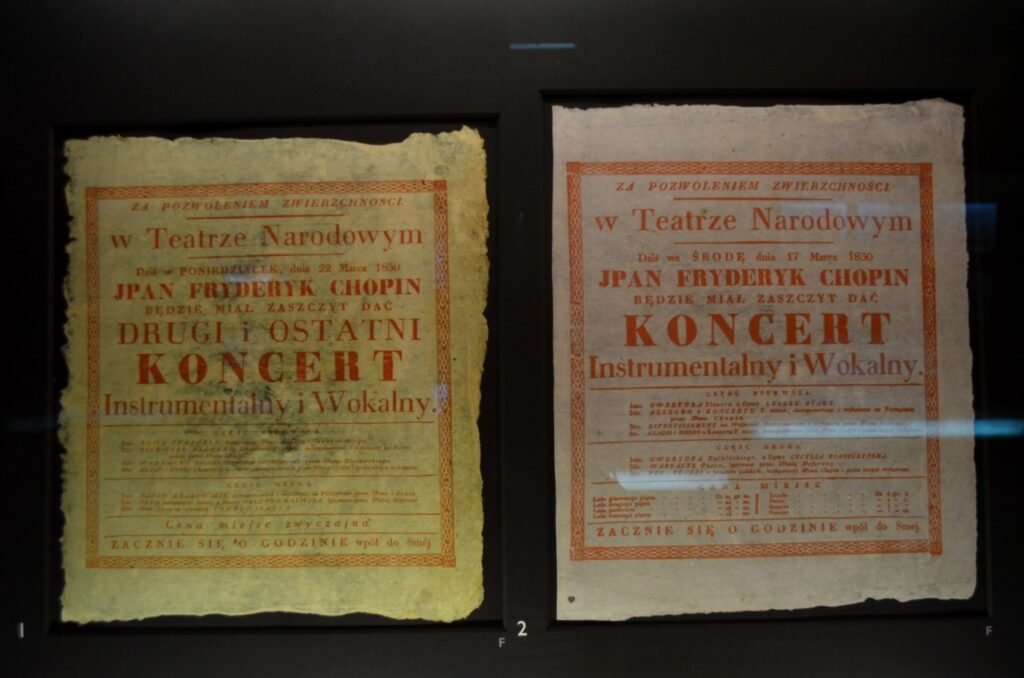
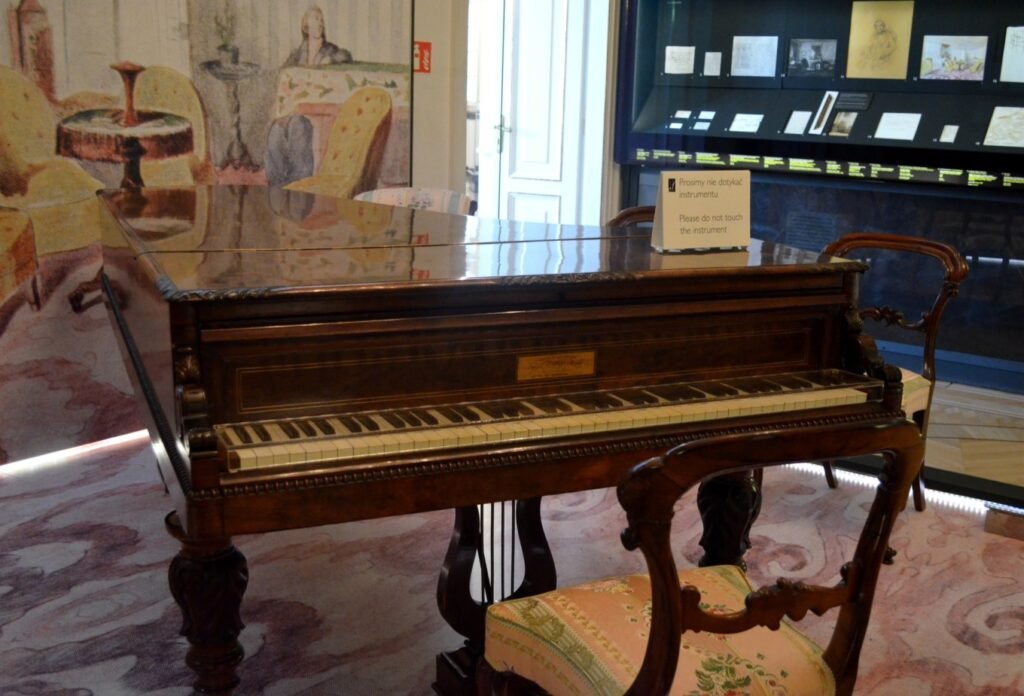
Warsaw’s Cuisine
For many travelers, local cuisine is an essential part of the journey. Polish cuisine is centered around pork, dairy products, and the world-famous vodka. While the cooking techniques may not be the most sophisticated, the affordable prices and generous portions make dining in Poland both satisfying and budget-friendly. A filling meal at an ordinary restaurant can be enjoyed for just a few dollars.
Before arriving, I had heard about Poland’s version of dumplings—Pierogi. Unlike Chinese dumplings, Pierogi come with a wider variety of fillings. In addition to the typical meat filling, they can also be stuffed with potatoes or even fruit. The dough is thicker, and the meat filling resembles a smooth paste, lacking the chunky texture and bite of Chinese dumplings.
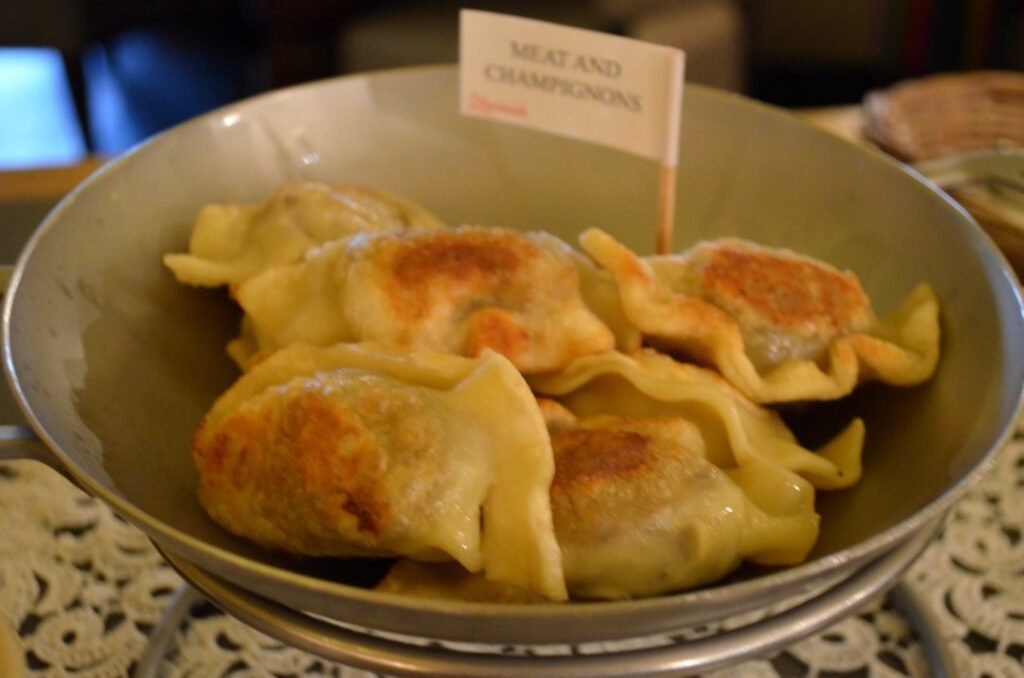
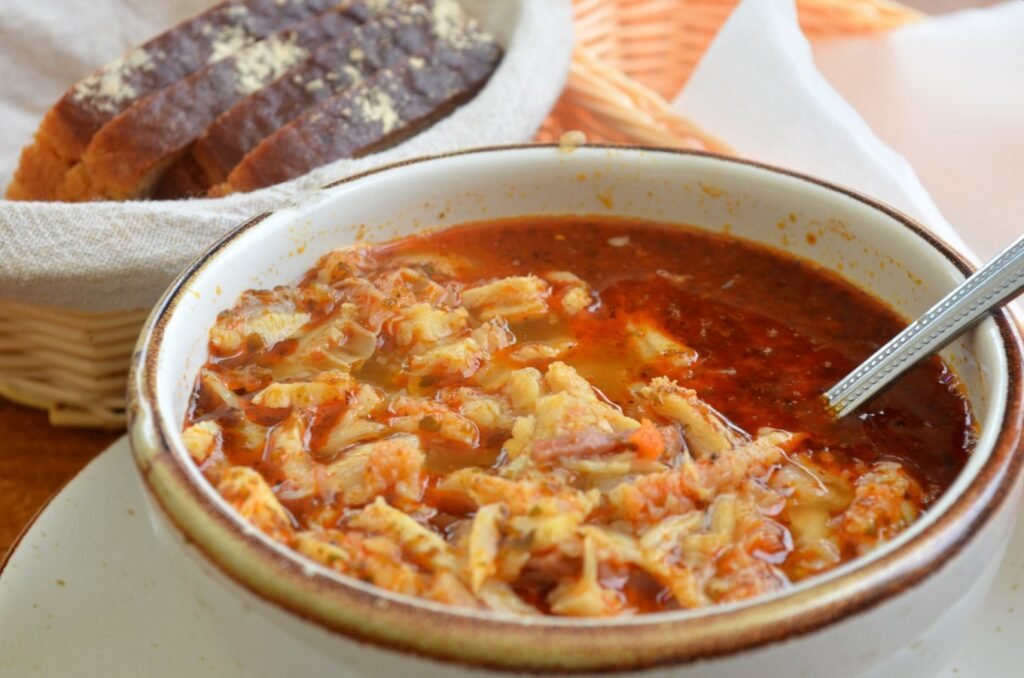
Compared to “Polish Dumplings,” the tripe soup here truly won my heart.
Many Eastern European countries use tripe and pork stomach to make soups, and after trying it a few times, I found that the quality of tripe soup varies across different restaurants. My favorite came from a distinctive chain restaurant in Warsaw. The portion was generous, with the tripe perfectly cooked to a tender yet firm texture. The broth was incredibly flavorful, rich with the aroma of black pepper and spices. Though it appeared to have a layer of red oil, it wasn’t spicy at all. After enjoying the springy tripe and taking a sip of the hearty soup with bread on the side, a wave of warmth spread through my stomach—a satisfying and delightful experience.
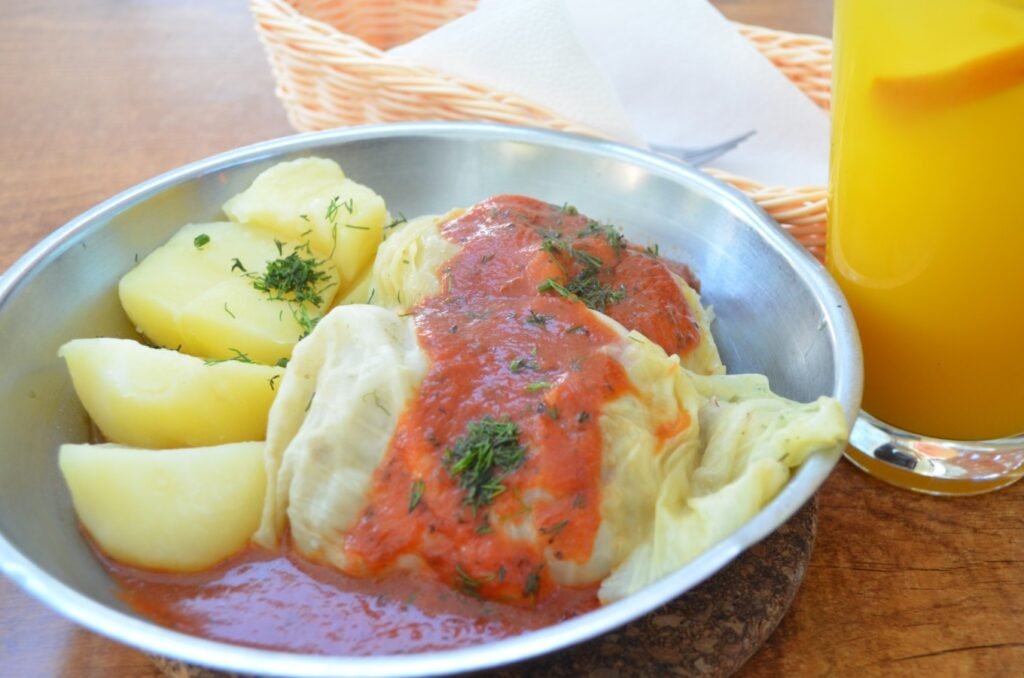
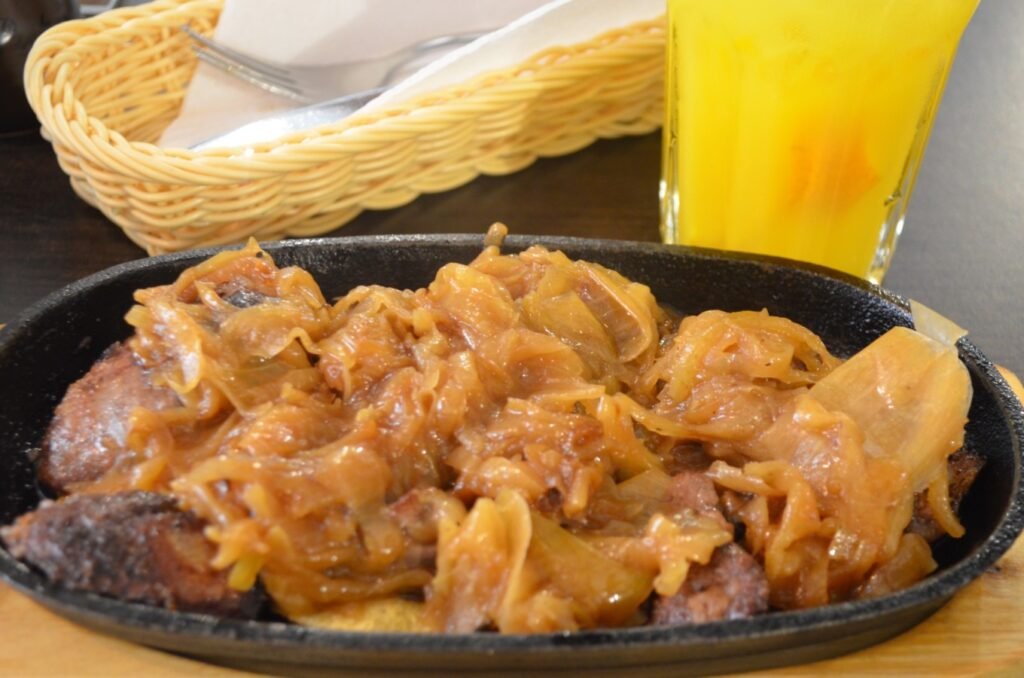
Local restaurants offer a wide variety of dishes with Polish and Eastern European characteristics, sometimes featuring unexpected combinations. For example, the apple with pork liver dish initially seemed unappetizing, but it turned out to be quite delicious. Another surprise was the cabbage rolls stuffed with pork, a dish I had heard about from friends in Germany and other Eastern European countries, but I hadn’t expected to try an authentic Polish version first.
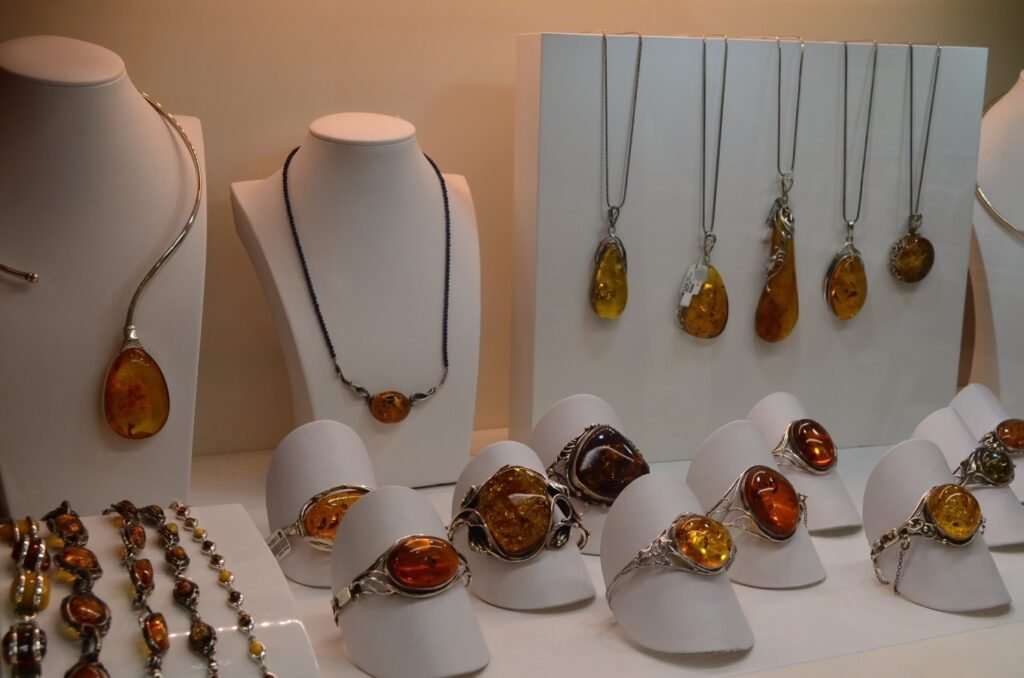
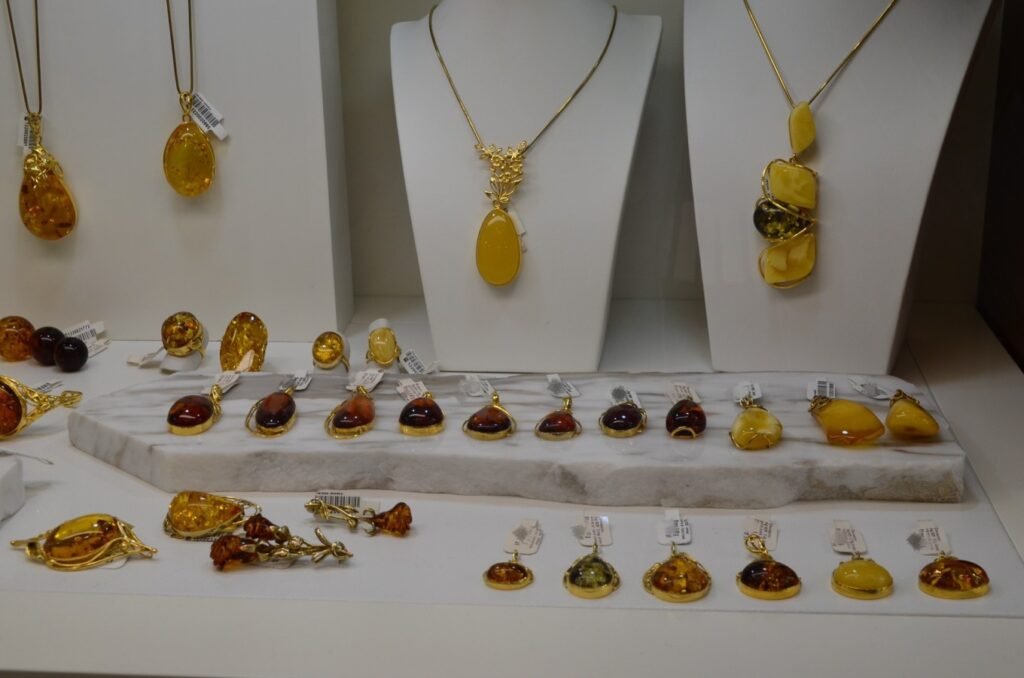
The Baltic Sea is home to some of the world’s finest amber, a well-known Polish specialty. Amber is a transparent organic fossil, formed from the resin of pine trees that fell and were buried under the earth millions of years ago, hardened through heat and pressure. The Baltic region produces 70-80% of the world’s amber. In Warsaw, especially near the Old Town, many jewelry shops specialize in amber products. Initially, I had little interest in amber, but one shop’s display caught my eye and made me stop.
The owner was a beautiful and elegant lady, radiating a gentle artistic charm, with captivating light blue eyes. Through our conversation, I learned she came from a family of amber jewelry designers and is now an independent designer herself. Unlike other retail stores, most of the pieces in her shop were her own creations. While preserving traditional styles, she introduced bright and playful elements into some collections, giving the ancient fossil a sense of vibrancy, making it more appealing to younger generations.
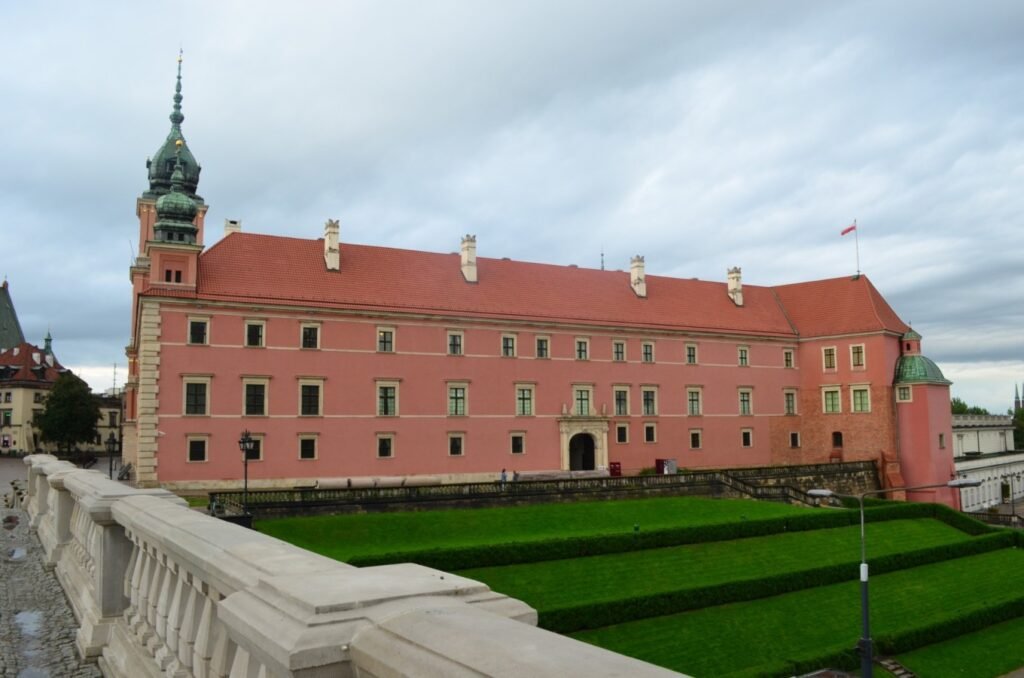
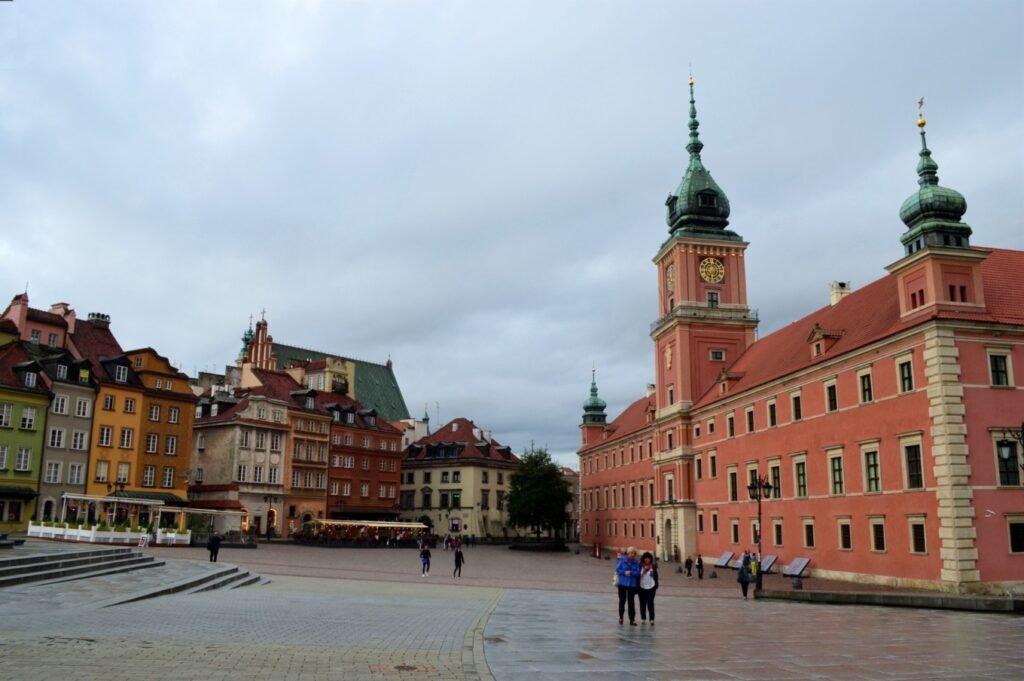
If Warsaw were a dish, it would undoubtedly be one with rich flavors and layers, requiring a long cooking process and several changes of tools along the way. Warsaw embodies both stubbornness and persistence, as well as gentleness and romance. It carries both valor and tragedy, alongside renewal and optimism. Every time I stand before the Old Town, every time I feel the heart of the piano poet, these qualities of Warsaw resonate deeply.
Travel Tips (Non-Commercial Recommendations):
Travel Methods:
For those who are proficient in the language, I highly recommend the Free Walking Tour. It’s a quick and systematic way to gain an understanding of the local historical and cultural background. Additionally, you can receive travel and food recommendations from local friends. With their informational brochures, you might also enjoy discounts at some attractions. You can search online for specific groups, themes, schedules, and participation methods.
Moreover, Warsaw’s Old Town and surrounding areas are not very large and can be easily explored on foot. If you prefer taking the bus, you can purchase tickets from the machines on the street or buy them directly on the bus.
Restaurants:
Gościniec or GOŚCINIEC Polskie Pierogi are my favorite local restaurants, where I’ve enjoyed the best tripe soup in Eastern Europe so far. I tried several dishes, all of which were excellent—highly recommended! Warsaw has many chain restaurants, so just search online to find them.
Zapiecek is another local chain restaurant, reputedly loved by locals for their dumplings. It was at their restaurant that I discovered my favorite dumplings and local hot drinks. There are many branches in Warsaw.
Amber Jewelry Store Recommendations:
The amber store mentioned in the text is called Warsaw Jewelry, located in the Old Town. The beautiful store owner is very friendly and patient, exuding a strong artistic aura. Most of the stunning pieces are personally designed and crafted by her, with many styles suitable for young people and reasonably priced. They come from a family of amber jewelry designers and have three stores in Warsaw Old Town:
- Warsaw Jewelry, address: Piwna 39/41 (the store I visited)
- Warsaw Jewelry, address: Piwna 15
- A new store opened in 2021 called Galeria Sawa, address: Rynek Starego Miasta 19/21 (or search for address Piwna 13)


